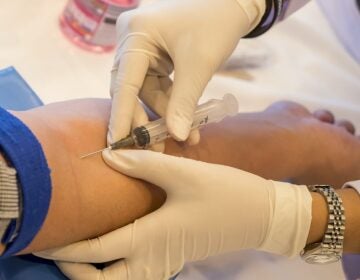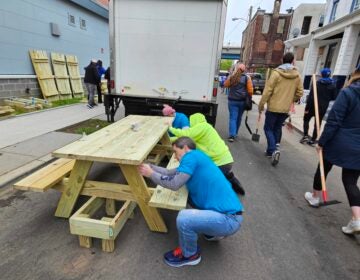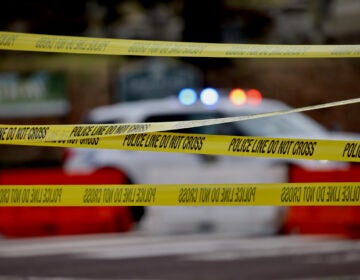East Falls community explores solutions to ‘deadly streets’
Labeled an “emergency meeting,” the East Falls Community Council convened Sunday night to speak about recent fatalities on local roadways and investigate means of preventing future incidents from occurring.
In response to invitations sent late last week, officials from the Philadelphia Police Department, Streets Department, and the Pennsylvania Department of Transportation were present, as was 4th District Councilman Curtis Jones, Jr.
Predicating this meeting, were two fatal incidents along Henry Ave. in or adjacent to East Falls.
The first, a head-on vehicular collision, claimed the life of a 22-year-old man.
The second, in which a vehicle struck and killed a pedestrian, occurred at the intersection of Henry Ave. and School House Lane.
Meg Greenfield, 1st Vice President of the East Falls Community Council and member of the East Falls Traffic Committee, presided over the meeting.
“We are thoroughly disgusted with what has not been done over the last ten years to make Henry Ave. safe,” she said.
Asking for commitments within specific timelines from the officials present, Greenfield began by imploring 39th Police District personnel to implement increased enforcement of speed limits and traffic-control devices, effectively immediately.
Within a period of a month, Greenfield asked the Streets Department – and, if applicable, PennDOT – for the installation of pedestrian crossing controls at Henry Ave. intersections.
In the long-term, she asked for increased installation of red-light cameras to monitor Henry Ave. Lastly, she resurrected a dormant plan for converting the East Falls portion of Henry Ave. into a “boulevard,” with a landscaped median that could assist in preventing head-on collisions.
Enforcing speed limits
Responding to Greenfield’s enjoinders to police was Captain Verdell Johnson, Commanding Officer of the 39th District.
Dispelling what he termed a “myth,” Captain Johnson informed those present that the Police Department does not routinely employ radar to enforce speed limits.
Instead, he noted, the PPD generally uses “speed timing,” – a technique that registers the time needed to travel between two points – but that, at present, the 39th District does not have this equipment, nor does it have an officer trained in its deployment.
Asked whether Pennsylvania State Police – the only police agency in the state authorized to use radar – could conduct radar-equipped patrols, Johnson noted that troopers do not typically patrol neighborhoods.
In light of this, Johnson pledged to requisition the necessary equipment, train his personnel, and deploy both within a month.
Speaking candidly, he told the audience that manpower limitations will prevent continuous patrolling of the corridor.
“We will not be able to have an officer on Henry Ave. 24/7,” he explained, but he suggested that an officer would be available approximately once a week for deterrence purposes.
Could red light cameras become a reality along Henry Ave.?
Given the limits of policing, East Falls resident Christina Spino asked the panel if there are technological solutions to supplant real-time enforcement.
Chris Vogler, Manager of Red Light Photo Enforcement for the Philadelphia Parking Authority, responded with an explanation of electronic surveillance.
Vogler related that there are two varieties of photo enforcement tools available – red-light cameras, such as the one at the intersection of Henry Ave. and Walnut Lane, and speed cameras, more accurately known as “speed on green.”
The cameras currently installed within the city operate strictly as red-light cameras, but do have “speed on green” capabilities, according to Vogler.
In order to implement this feature, he continued, a mandate will have to come from Harrisburg, as the entire red-light camera program is a state legislative initiative, which is funded through June of this year.
With a renewal process pending, Vogler suggested that this could be a “prime opportunity” to introduce changes – i.e. speed on green – to the bill.
“It’s really a state issue,” he concluded.
Turning his attention to localized concerns, Vogler also addressed the addition of a red-light camera at the intersection of Henry Ave. and School House Lane.
He related that a study had been conducted of the Henry and Ridge avenue corridors approximately 18 months ago. At the time, it was determined that the School House lane intersection was unsuitable for a camera, due to obstructions – trees and wires – and potential right of way issues.
“It might look like a great intersection for cameras,” said Vogler, “but from a technical standpoint, this doesn’t necessarily work.”
He offered that his department would be willing to reexamine this intersection for camera placement.
Implementing a long-term traffic safety plan
Speaking to traffic regulation was Clarena Tolson, Commissioner of the Philadelphia Streets Department, and Lester Toaso, Southeastern Pennsylvania District Executive for the Pennsylvania Department of Transportation [PennDOT].
Noting that traffic management is never as straightforward as it may seem, Tolson emphasized the importance of collaboration between the community, the city, and state.
Apropos to Henry Ave, she said a prior initiative to study traffic safety on this corridor had been abandoned due to lack of funding. Recently, she noted, federal funding had been allocated to the state to study potential improvements and implement them.
Taoso explained the federally-funded program, referred to as the Henry Ave. Safety Improvement Project, which he said will focus on improving vehicular and pedestrian safety throughout the length of Henry Ave.
A designer and consultant will be under contract within a month.
As the design stages progress, preliminary engineering will call for a detailed crash analysis along the whole corridor, along with a public involvement meeting for community comment and review.
The community meeting is tentatively slated for mid-summer.
Emphasizing that this is a long-term project – with a year-long design phase, and final implementation by 2015 – Taoso said that, in the short-term, his department “will do what we can to provide as many safety improvements as possible along Henry Ave.”
He noted that, given a traffic volume of 16,000 to 30,000 cars per day, there are some things that can’t be done on Henry Ave – namely speed tables, raised intersections, and the elimination of a lane.
What Toaso can do, he stated, is to modernize signals from start to finish, add pedestrian countdowns to intersections, and create left turn lanes.
He added that PennDOT will work with the Streets Department to look into traffic volumes and crash clusters to see what his department can do in the “immediate now” to prevent accidents.
Tolson pledged to organize a Henry Ave. safety committee, analogous to one currently in existence on Roosevelt Blvd.
Councilman Jones – who asked for a moment of silence at the beginning of the meeting – emphasized that he is committed to bringing together elements of the community and government to find workable solutions.
“We have to balance needs of public safety with traffic flow,” he said, “but we’re going to err on the side of public safety.”
WHYY is your source for fact-based, in-depth journalism and information. As a nonprofit organization, we rely on financial support from readers like you. Please give today.




